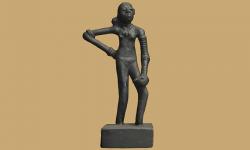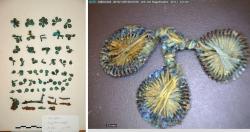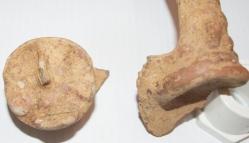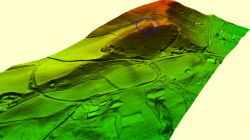INSTITUT SUPERIEUR D'ANTHROPOLOGIE
INSTITUTE OF ANTHROPOLOGY
ONLINE COURSES / COURS A DISTANCE
SPRING TERM : APRIL 2014
REGISTER NOW
PAKISTAN –  Moenjodaro - Sindh, the provincial government is sending a request to Islamabad for asking India to return the famous statue of the Dancing Girl, which is in possession of the Indian authorities since 1946. The two most famous artefacts belonging to Moenjodaro, regarded as one of the world’s most ancient planned cities, are the King Priest and the Dancing Girl. Officials said the two relics had been transported by British archaeologist Sir Mortimer Wheeler to Delhi in 1946 to be put in an exhibition and had remained there since then.
Moenjodaro - Sindh, the provincial government is sending a request to Islamabad for asking India to return the famous statue of the Dancing Girl, which is in possession of the Indian authorities since 1946. The two most famous artefacts belonging to Moenjodaro, regarded as one of the world’s most ancient planned cities, are the King Priest and the Dancing Girl. Officials said the two relics had been transported by British archaeologist Sir Mortimer Wheeler to Delhi in 1946 to be put in an exhibition and had remained there since then.
http://www.dawn.com/news/1084327/sindh-seeks-return-of-moenjodaros-dancing-girl-from-india
DANEMARK –  Roskilde - During excavations in Roskilde Cathedral, Denmark, archaeologists found burials dating between 11th – 17th centuries and included a grave that obviously belonged to a noblewoman. She had been buried with her head resting on a pillow sewn with gold threads and had been wearing a maiden crown. The crown was found at the head of the grave and had initially been interpreted as a headband. Most of the decoration consists of many small flowers made of twisted copper wire wrapped with silk thread. The metal salts in the copper have ensured the silk thread has been preserved. As the thin iron band had corroded that held the pieces together, it was no longer possible to see exactly how this crown was arranged. However, most of the components are relatively well preserved, and using written sources and images from the period, it is possible to give some suggestions as to how and in what context it has been worn. During the medieval period married women would cover their hair with a veil, while unmarried women/maidens, would wear their hair loose. By the 1600s, during the Renaissance, it was fashionable for married women to wear embroidered and pearl studded caps, while unmarried women would don a wreath or crown, in most cases created from beads. Numerous family paintings – called epitafie - hung in churches around Denmark show women wearing these types of maiden crown. All the items have now come to the National Museum Conservation Department in Brede.
Roskilde - During excavations in Roskilde Cathedral, Denmark, archaeologists found burials dating between 11th – 17th centuries and included a grave that obviously belonged to a noblewoman. She had been buried with her head resting on a pillow sewn with gold threads and had been wearing a maiden crown. The crown was found at the head of the grave and had initially been interpreted as a headband. Most of the decoration consists of many small flowers made of twisted copper wire wrapped with silk thread. The metal salts in the copper have ensured the silk thread has been preserved. As the thin iron band had corroded that held the pieces together, it was no longer possible to see exactly how this crown was arranged. However, most of the components are relatively well preserved, and using written sources and images from the period, it is possible to give some suggestions as to how and in what context it has been worn. During the medieval period married women would cover their hair with a veil, while unmarried women/maidens, would wear their hair loose. By the 1600s, during the Renaissance, it was fashionable for married women to wear embroidered and pearl studded caps, while unmarried women would don a wreath or crown, in most cases created from beads. Numerous family paintings – called epitafie - hung in churches around Denmark show women wearing these types of maiden crown. All the items have now come to the National Museum Conservation Department in Brede.
http://www.pasthorizonspr.com/index.php/archives/02/2014/discovery-of-a-maiden-crown-in-roskilde-cathedral-burial
Iles Vierges –  St Thomas - He’s digging up the past—somewhere between 200 BC and 400 AD—in an unexpected archaeological excavation in downtown Charlotte Amalie on the Caribbean island of St. Thomas in the US Virgin Islands David Hayes, who got his MS in Industrial Archaeology from Michigan Technological University in 2000, is principal investigator for a year-old dig that began when he noticed pottery popping out of a highway improvement site. The highway work was stopped, and the pieces have since been dated to early ceramic makers and farmers of the Saladoid era, 2000 to 1,400 years ago. “This is a major discovery,” Hayes said. “Very rich.” In addition to the shards, he’s found animal bones, shell beads, shell bows “and a lot more, like faces in clay.” These types of finds are rare in the Caribbean, he said.“Commonly there are multiple cultures using the same site, and there is a mixture of the material from them, Hayes explained. “This site, for some reason, was not used much after about 500 AD, so we have a site that closed down, and the material is all from the single culture. We will be looking for the reason the people did not reuse the site later.”
St Thomas - He’s digging up the past—somewhere between 200 BC and 400 AD—in an unexpected archaeological excavation in downtown Charlotte Amalie on the Caribbean island of St. Thomas in the US Virgin Islands David Hayes, who got his MS in Industrial Archaeology from Michigan Technological University in 2000, is principal investigator for a year-old dig that began when he noticed pottery popping out of a highway improvement site. The highway work was stopped, and the pieces have since been dated to early ceramic makers and farmers of the Saladoid era, 2000 to 1,400 years ago. “This is a major discovery,” Hayes said. “Very rich.” In addition to the shards, he’s found animal bones, shell beads, shell bows “and a lot more, like faces in clay.” These types of finds are rare in the Caribbean, he said.“Commonly there are multiple cultures using the same site, and there is a mixture of the material from them, Hayes explained. “This site, for some reason, was not used much after about 500 AD, so we have a site that closed down, and the material is all from the single culture. We will be looking for the reason the people did not reuse the site later.”
http://www.mtu.edu/news/stories/2014/january/story102378.html
ROYAUME UNI-  Black Down - A new form of airborne laser scanning used in an archaeological survey near Haslemere may have revealed an ancient hill fort and burial mound. The scanner, known as LiDAR, uses infra-red laser to see beneath trees and map inaccessible landscapes. The survey, carried out by the National Trust at Black Down, has found evidence that people may have lived there from 10,000 years ago. National Trust archaeologist, Tom Dommett, said: "LiDAR reveals the humps and bumps which can indicate archaeological sites. "We are particularly interested in some circular earthworks near the Temple of the Winds, which may indicate Bronze Age burial sites, and a possible Iron Age settlement area lower down the hillside at Castle Copse."
Black Down - A new form of airborne laser scanning used in an archaeological survey near Haslemere may have revealed an ancient hill fort and burial mound. The scanner, known as LiDAR, uses infra-red laser to see beneath trees and map inaccessible landscapes. The survey, carried out by the National Trust at Black Down, has found evidence that people may have lived there from 10,000 years ago. National Trust archaeologist, Tom Dommett, said: "LiDAR reveals the humps and bumps which can indicate archaeological sites. "We are particularly interested in some circular earthworks near the Temple of the Winds, which may indicate Bronze Age burial sites, and a possible Iron Age settlement area lower down the hillside at Castle Copse."
http://www.bbc.co.uk/news/uk-england-surrey-26006992?
CHINE - Heping - Several discoveries made by an international collaboration between Taiwanese and Spanish scholars have presented evidence of human activity on Heping Island (和平島), northeast of Keelung, from around 3,000 years ago. In order to study the relationship between the former colonizer Holland and local aborigines in Keelung, an archaeology team sponsored by Taiwan's National Science Council (NSC) and the Consejo Superior de Investigaciones Cientificas (CSIC) was formed. It took the team three years and two excavations to finally complete the project and plan an exhibition, titled “From the Renaissance to the Neolithic: The Spanish fortress of Kelang (Taiwan) and its earlier Austronesian and Prehistoric environment,” to show their discoveries. During the excavations, the team discovered artifacts from several different periods. Among all the findings, the most intriguing discoveries were artifacts like polished stone knives, stone chisels from the Neolithic period (Yuanshan Culture) and pottery from the Iron Age (Shisanhang Culture). These discoveries show that there was human activity in Northern Taiwan dating back roughly 3,000 years. As for the main goal of the project, there was only one item of European origin — a bronze buckle — which was of little help to researchers seeking to understand more about the former colonizer. However, the team did discover the foundation of a large European-style building. According to historians, it may be the first Catholic church in Taiwan, or perhaps the house of a Dutch governor. It will take more research to identify the historical remnants. Jose Eugenio Borao Mateo, a professor at National Taiwan University and also one of the leaders of the project, said, “People will have a better understanding of the long history of Taiwan as well as the role of a small island at the entrance of a harbor in history. This is something else that people can understand about Keelung other than pop culture.” All the discoveries are being displayed at the Keelung City Indigenous Hall (基隆原住民文化會館) until March 15. Borao Mateo said it is a rare opportunity to have this exhibition and allow people to learn more of the history of this island, given that the archaeology team had to overcome various challenges to complete the task. Borao Mateo pointed out that the most challenging task was to get permission for their team to begin the excavations. When the team had to excavate in an urban area, the task became even harder because landlords were concerned that the work would affect the value of their lands. In addition, the team also faced challenges from the weather. “You have to wait for good weather, something difficult in Keelung where it usually rains in winter,” said Borao Mateo.
http://www.chinapost.com.tw/taiwan/national/national-news/2014/02/02/399669/Historical-artifacts.htm